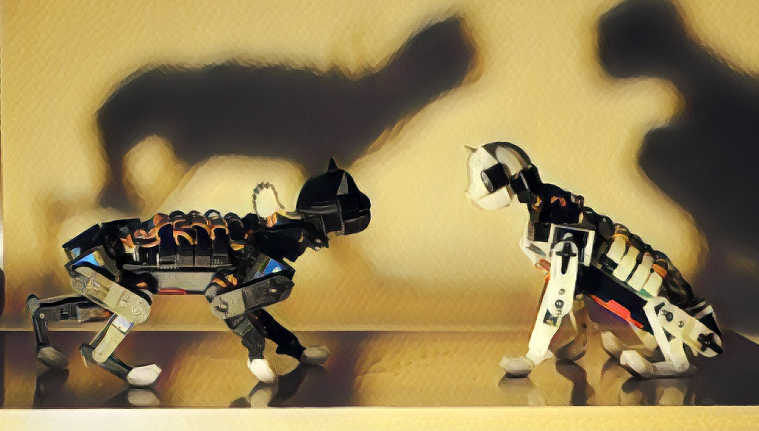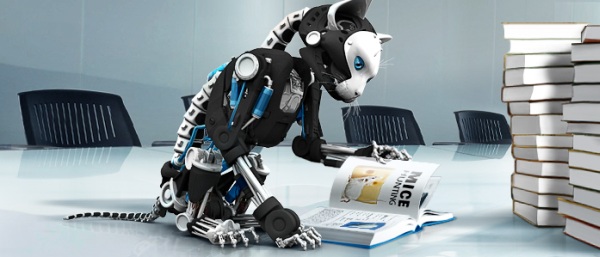A few months ago, I was browsing reviews of robot vacuum cleaners. While reading the user comments, I noticed that many people talk about a vacuum as if it were a pet—or even as if it were their child. One young couple, for example, would watch with misty eyes in the evenings as their little robot learned to navigate around chair and table legs and other obstacles in the room. And when, at the end, it neatly climbed onto its charger and drifted off to sleep, the couple dozed off as well. No doubt, a robot fits the hipster lifestyle better than a dog or cat—plus, it cleans and doesn’t have to be cleaned up after. But as Uncle Ábel would say: no, no!
A few years ago, Aibo, the digital pet (in Japanese 相棒, meaning roughly “buddy”), stirred up bourgeois sensibilities. Sony introduced the prototype in 1998, and on May 11, 1999—twenty years ago—it launched it on the market. Until 2006, a new version was released every year, after which they announced the discontinuation of production. Product support was gradually phased out, and in 2013 support for the last model, the ERS-7M3, was finally terminated.
Time passed, and Sony eventually decided there was still potential in the idea. Last February they released the new Aibo, the ERS-1000. This new ivory-colored pup is capable of much more than its predecessors: its eyes are OLED displays that allow it to express emotions. One can debate whether it truly has emotions or not, but its behavior makes it seem as if it does. It recognizes family members and other Aibos, responds to human speech, and enjoys being petted. As with the earlier versions, Sony also provides development software for it, allowing new tricks to be taught (this is how Aibos ended up in RoboCup, where the team from the University of New South Wales has so far been the most successful):
So far, around 50,000 units have been sold. Despite the rather steep price of the new model (USD 2,900 = HUF 814,000), Sony can barely keep up with demand. And buying the dog alone isn’t enough—you also need to subscribe to Sony’s cloud service! The Aibos are constantly online via the mobile network, connected to Sony’s servers, where artificial intelligence analyzes the activity of every dog each day and updates their code without any human intervention.
So, for the price of a used car you can buy yourself a very cute rubber dog. The advantages: it doesn’t pee indoors, it doesn’t shed, and you don’t have to take it to the vet. In return, though, it’s packed with cameras and sensors—through which one of the world’s most advanced artificial intelligences can watch your every move at home. Cool, right? For those who can’t afford such a thing, or who get itchy at the thought of a super-smart Big Brother spying under the kitchen table, there’s always the cat. The do-it-yourself robot cat.

The OpenCat project is all about building a robot cat! Although the source code is available for download, the project, despite its name, is unfortunately not entirely open. For example, the files needed for 3D printing are not accessible. It seems that the developer, Rongzhong Li, originally intended it to be fully open-source, but by now it looks as though he is working toward developing a commercial version. The following demo shows the current state of development:
One thing’s for sure—it won’t be climbing the curtains anytime soon! The most interesting aspect of the hardware is that it uses an Arduino for motion control and a Raspberry Pi for higher-level functions. According to Rongzhong Li, there are two versions: a mini version with only 8 degrees of freedom, controlled by a single Arduino board. This one is mainly intended for STEM (science, technology, engineering, mathematics) education and hobbyist robot builders, and its price will be similar to other such kits (I’d estimate around HUF 40,000–80,000). Assembly takes less than an hour, but it can only follow command instructions.
The full version uses a Raspberry Pi along with a more advanced 16-degree-of-freedom motion control module. This one is capable of moving on its own and making decisions. In addition to Wi-Fi and Bluetooth, the Pi also supports interfaces for ground contact, touch, infrared, distance sensing, sound, and night vision. Several bionic frame designs have already been sketched out, with morphologies resembling that of a real cat.
Note: For those who might not know: Arduino is a free software, open-source electronics development platform invented by a few Italian students in the early 2000s. The hardware is also released under a Creative Commons license, and all the materials needed for manufacturing are available on their website—so there are countless clones and a huge variety of inexpensive accessories on the market. The Raspberry Pi is likewise a tiny single-board computer, developed in the United Kingdom by the Raspberry Pi Foundation primarily for educational purposes. Most units are manufactured by Sony in Wales, and the Pi is used in robots, instruments, process control, information terminals, and more. It can run Linux, FreeBSD, or even Windows, and it offers incomparably greater performance than the Arduino, which was designed for simpler tasks.
I wish Li the best of luck with the development, but I’ll quietly point out that if the hardware and software were truly open-source, the entire STEM community, big and small, could contribute to its progress. It could even become a successful business that way—just as Arduino did.
In any case, it’s already clear that the OpenCat project looks more promising than the robot cats currently available on the market, which for some reason don’t even come close to the quality of the early Aibos. They’re more reminiscent of Georgian-era automata. Take, for example, the Zoomer Kitty, which was (or rather, who was) available in our country as well:
Zoomer Kitty is just a toy for five-year-olds—something that quickly gets boring. As a counterpoint, let me show you an adult toy: another cat, but a very, very expensive one. This is the WildCat, developed by Boston Dynamics as part of the DARPA M3 program.
Boston Dynamics began as a spin-off from the Massachusetts Institute of Technology and has an extraordinary engineering team. The WildCat is one of their experimental robots—the fastest four-legged robot in the world, capable of running at 32 km/h. It can gallop, trot, or bound while maneuvering like a horse or dog, maintaining balance and adapting to rough terrain. It is fully autonomous, able to plan its own path and movements.
It’s powered by a methanol-fueled internal combustion engine—and it looks pretty badass when it revs up and the smoke pours out around it. The project is fundamentally military in nature: the army is working on developing robots that can replace soldiers on the battlefield, and that can operate independently on difficult terrain—handling logistical tasks for now, and tactical ones later.
The wildcat is rather terrifying—more of a steampunk horse than a cat. To end on something a little more pleasant (and since I already mentioned Georgian-era automata), let me show you a beautiful automaton. It isn’t a cat but a swan, so it doesn’t quite fit here, yet its astonishingly refined movements demonstrate that today’s machines still have a lot of room for improvement:
The astonishing thing is that this swan is entirely mechanical, operated by a wind-up clockwork mechanism. Today it can be seen at the Bowes Museum; it was built in 1773—almost 250 years ago—by John Joseph Merlin.
Merlin was a clockmaker, instrument maker, inventor, and showman. A true eccentric, he often appeared in social circles dressed as a maid, carrying a tray of drinks. He also invented roller skates, which he used to glide through aristocratic halls while serving his refreshments. On one occasion this went very badly for him: he couldn’t slow down the skates and crashed into a Venetian mirror, shattering it to pieces.
Eccentric as he was, he was also a brilliant artist and a talented engineer—that much must be acknowledged. Speaking of talent and Venetian mirrors! We all know the joke, don’t we? Standing in the White House before a painting:
— Now this one is definitely a true-born, sneaky Hungarian Gypsy!
— No, that’s a Venetian mirror in Baroque style.

